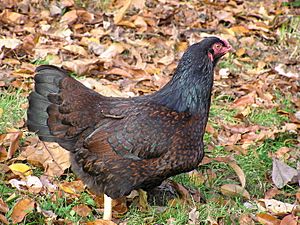Indian Game facts for kids

Dark Indian Game
|
|
| Conservation status | FAO (2007): not at risk |
|---|---|
| Country of origin | United Kingdom |
| Distribution | world-wide |
| Use |
|
| Traits | |
| Weight |
|
| Egg colour | light brown |
| Classification | |
| APA | English |
| EE | yes |
| PCGB | heavy: hard feather |
|
|
The Indian Game is a special type of chicken breed that first came from England. It's known for being very strong and muscular. People raise these chickens today mostly for their meat or to show them off in poultry shows. This breed started in the early 1800s in the English counties of Cornwall and Devon.
In the United States, this chicken is called the Cornish. A white version, known as the White Cornish, was also developed there. This white chicken is very important in modern chicken farming. It is used to create fast-growing chickens for meat, sometimes called "game hens".
Contents
History of the Indian Game Chicken
The Indian Game chicken breed was created by Sir Walter Gilbert, 1st Baronet around 1820. It was originally meant to be a fighting chicken. However, it turned out not to be very good at fighting.
Name Changes and Recognition
The American Poultry Association officially recognized this breed in 1893. In America, it was first known as the Indian Game. But in 1905, its name was changed to Cornish Indian Game.
People found this name confusing because it sounded like the chicken came from India. Also, the word "Game" was not very popular in the name. So, in 1910, the name was simplified to just the Cornish.
In Australia, these chickens are still known only as Indian Game. In the United Kingdom, both names are sometimes used. However, the official name, according to the Poultry Club of Great Britain, is Indian Game.
What Makes Indian Game Chickens Special?
The Indian Game is a large and sturdy bird. It has short legs and a very wide, deep chest. Some male birds can be so broad-chested and short-legged that it makes it hard for them to reproduce.
Colors and Feathers
In the United Kingdom, three main colors are recognized for this breed:
- The dark color, which was the original.
- The Jubilee color.
- The double-laced blue, which is quite rare.
The Entente Européenne d'Aviculture et de Cuniculture and some European countries also recognize a white version. In the United States, the Cornish chicken comes in four recognized colors:
- Dark (added in 1893)
- White (added in 1898)
- White-laced red (added in 1909)
- Buff (added in 1938)
Health and Care
Indian Game chickens are generally strong and can resist many common chicken diseases. However, they can be affected by parasites. Their feathers are thin and hard, without much soft down. This means they might feel the cold more easily. Cold weather can sometimes slow down their breeding in early spring.
How Indian Game Chickens Are Used
The Indian Game chicken was first bred for fighting, but it wasn't successful as a fighting bird. Instead, people discovered it was excellent for meat production.
It became very popular for cross-breeding with other well-known meat breeds. These included the Dorking, Orpington, and Sussex breeds. This helped create even better meat chickens.
Indian Game hens are not known for laying many eggs. Their eggs are small and light brown. A hen might lay about 80 eggs in a year.

